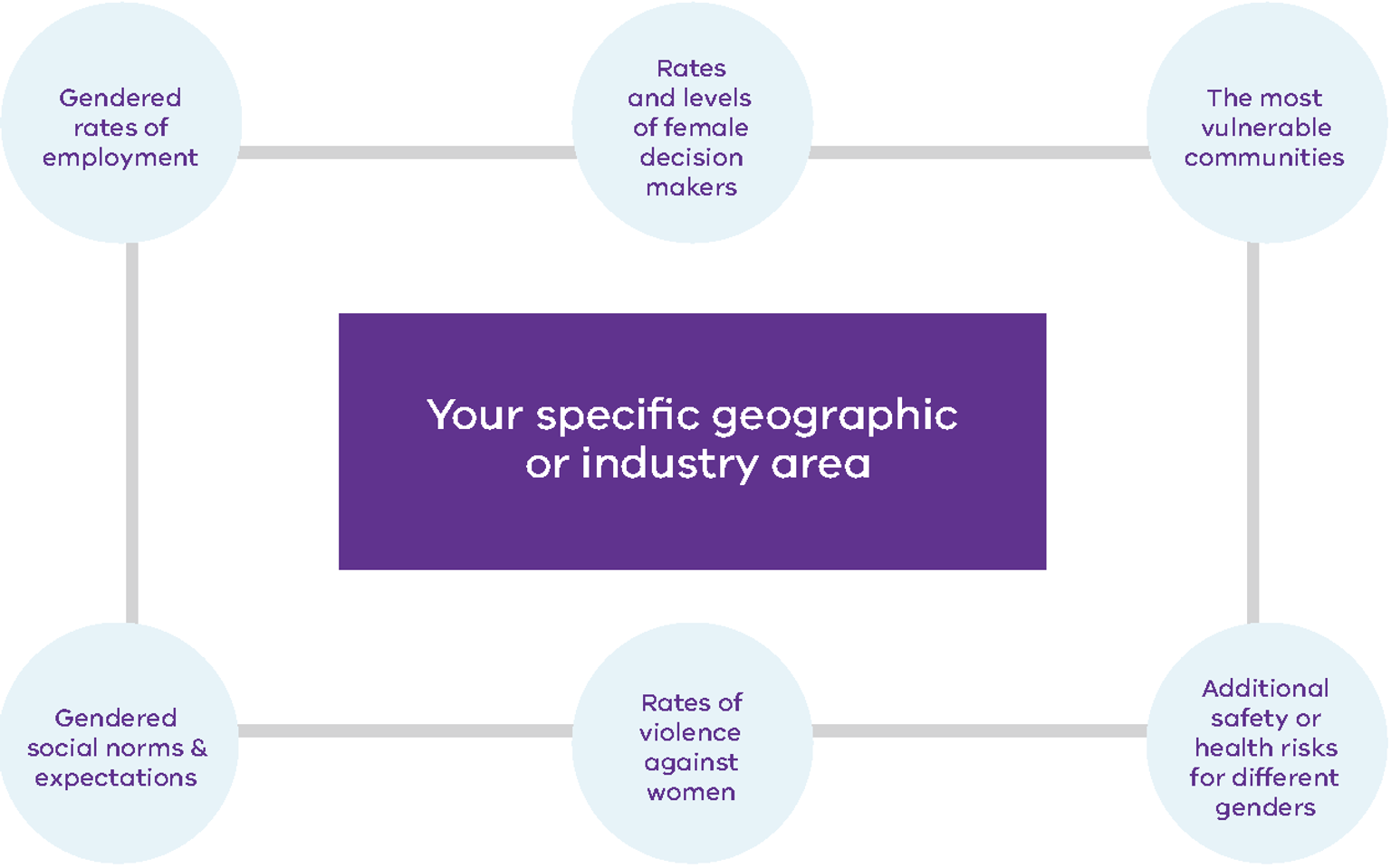In this step you will:
- Identify the issues that your policy, service or program is aiming to address.
- Think about how gender, and other inequalities, might shape the policy issue, program or service you are working on.
Tip: If you have already undertaken research and data collection on the gender implications of your policy, program or service then you may not need to spend as much time on this step. But even if you have undertaken extensive desktop research, it is important to build your understanding through meaningful stakeholder engagement. Part C can support this.
Part A: What information might you need?
There are three areas where it may be helpful to gather information to better understand how gender shapes the context for your policy, program, or service:
- Who is likely to be affected?
- What are the lived experiences of diverse groups?
- What different impacts may be likely for different people?
For each area consider:
- Do you already have this information?
- If not, where could you find this information?
Parts B and C of this section provide guidance on using internal data, desktop research and conducting meaningful stakeholder consultations.
Tip: If the policy, program or service you are assessing is small and discrete you may not need in-depth information in all areas.
Public entities
Have you considered:
- Who is accessing the services you provide? Are there groups who are not represented as much as you would expect?
- What does the data say about how women, men and gender diverse people experience your organisation’s focus area(s) such as healthcare, sport, the arts, transport?
Universities
Have you considered taking a collaborative approach to the assessment process? The unit responsible for equality and diversity, the relevant policy/program owner, the human resources department or student services may all have a role to play.
See below for a checklist of questions that can help you to collect this information. It is a good idea to work in teams or with a colleague to consider these questions.
Guiding questions: Information to understand the policy context
Tip: Has your project, branch or department area done any previous work to gather perspectives from different genders and population groups that could be used to build an understanding of the context?
This might include previous research projects, consultations and submissions, enquiries and complaints logs, census findings, survey data or project evaluations.
You may not need to collect new data but can simply use existing data sets if they contain the information you need.
Part B: How can you use data and research to get the information you need?
In Part A you will have thought about the information you already have as well as further information you might need.
This part is designed to support you to think about how you can use other data and research sources to build your understanding of how gender shapes the context you are working in.
Look back at Template 2 and where you have identified you need more information. At the end of this part you should be able to fill in the data and research sources you think will help you to fill these gaps.
Tip: If you are a smaller organisation, consider if you could pool resources with other organisations to develop a shared database of evidence, such as research reports or population data.
You can build your understanding of how gender shapes the context of a policy, program or service by:
- Using and collecting disaggregated data.
- Seeking out gender-specific research related to the policy, program or service area you are working on.
This toolkit looks at three main sources of information:
- Internal data
- Desktop research
- Meaningful stakeholder engagement
Using internal data
In scoping, researching and designing new policies, programs and services, it can be useful to consider what internal sex- or gender-disaggregated data is available to, or collected by, your organisation.
This could be available in the form of:
- previous commissioned research and policy reports;
- project and program evaluation reports;
- complaints handling data;
- customer and end-user data including social media data;
- consultation and policy submissions.
Could the design of your policy, program or service area benefit from more disaggregated data to better understand how gender intersects with issues of race, age, sexual orientation, gender identity, ability and socio-economic factors? If no disaggregated data is available, consider if you can use other methods such as stakeholder engagement to understand the potential impacts by gender and other intersectional issues.
Take the next step: Advocate for disaggregated data
Data that shows impacts broken down by gender and other attributes is still limited. The new obligations under the Gender Equality Act could provide a good opportunity to advocate for the collection of disaggregated data in your organisation.
Desktop research
Desktop research is a review of existing research for information relevant to a project’s needs.
View our Data sources for conducting a GIA page for statistics and other resources to support this step. On this page you will find a list of open-source Victorian and Australian research and data on gender, by different indicators, including workforce participation, education, health, and violence against women. This should be a helpful starting point. The diagram below also provides some ideas on ways you could focus your research.
For more information
To read more about desktop research see the Victorian Government website: www.vic.gov.au/desktop-research
You can also find a useful step-by-step guide to conducting desktop research here: www.thisisservicedesigndoing.com/methods/secondary-research
You may also have access to the Victorian Government Library Service to access academic journals and previous government evaluations and reports on issues related to gender.
Victoria’s Gender Equality Baseline Report 2019 provides an overview of the current status of gender equality in Victoria and is a useful reference.
Local Government Victoria has produced a Gender Equity in Local Government Best Practice Guide which contains useful data and resources.
Tip: Are there avenues to gather perspectives directly from women and diverse communities to build your understanding of the context, such as research made by and for community groups?
Has any research been conducted to specifically analyse intersectional perspectives on the policy, program or service you are investigating?
For example, is there information available to understand the different rates and types of violence experienced by different genders, and how this intersects with other forms of disadvantage and discrimination, to shape peoples’ sense of safety and wellbeing?
Take the next step: Quantitative Analysis
If you have scope to extend your research even further, you could undertake your own quantitative analysis. A quantitative analysis tool has been developed to support this process including identifying indicators, estimating policy impacts and interpreting the outputs. Access the Quantitative Analysis Tool.
Part C: The importance of consultation and meaningful stakeholder engagement
Applying a gender lens to stakeholder engagement means taking time to actively seek out the knowledge, perspectives and experiences of women, men and gender diverse groups on all policies, programs and services, not just initiatives targeted at them. It is about creating a more empowering space for all members of the Victorian community to take part in planning and building responsive policies, programs and services.
Inclusive stakeholder engagement recognises the diversity within each community and of individuals. It also recognises that intersectionality can further exacerbate barriers to public participation and engagement and that it is crucial that everyone is given an opportunity and support to participate.
Universities and TAFEs
Have you considered if your university or TAFE has any specific gender equality groups or networks that should be consulted such as Women in Engineering, Women in STEMM, or LGBTIQ+ networks?
Below, you will find general resources to support stakeholder engagement such as how to undertake stakeholder mapping and how to create a stakeholder engagement plan. As part of this planning you should consider how you will apply a gender lens and ensure you are undertaking inclusive stakeholder engagement. The checklists in this Part are designed to assist with this.
Resources to support stakeholder engagement
Stakeholder Engagement and Consultation Summary
A simple online summary of stakeholder engagement from BCcampus.
Engage Victoria
An online consultation tool for use by Victorian Government departments and agencies.
Tip: Consider establishing a women’s advisory committee and/or an internal gender equality working group to advise on gender equality issues and support the consultation process.
Checklist to support meaningful and inclusive stakeholder engagement
Participation should be safe, empowering and respectful.
| Who to engage with | How to engage |
| Have you engaged with the ‘users’ of your policy, program or service? | How will you make your stakeholder engagement accessible? Consider things like the time of day, venue accessibility, and interpretation services. |
| Have you spoken with local women’s organisations or peak bodies that represent diverse groups? This may help to identify barriers and impacts you would not have thought about. | Are there existing mechanisms already in place to seek stakeholder views that could be used for engagement? |
| Do the stakeholders you are engaging represent the level of diversity seen in the population that is going to be affected? If not, you may be missing valuable insights. | How will you respect and create space for participants’ own contextual understanding, knowledge and lived experiences? |
| Have you thought about how you will share the learnings, process of decision-making and outcomes with participating stakeholders? |
Tip: Existing governance bodies may be useful to engage with on your policy, program or service or to assist you to identify groups or bodies that should be engaged with.
These include:
- the Commission for Children and Young People, which provides a voice for children and young people;
- the Victim Survivors’ Advisory Council, which provides insight from the lived experience of family violence victim survivors into the design and implementation of family violence reforms; and
- the Victorian Multicultural Commission, as the voice of Victoria’s culturally and linguistically diverse communities.
Universities
Have you considered, if your university participates in the SAGE Project (Science in Australia Gender Equity Project), could your gender impact assessment work support an Athena SWAN Award application?
Practical example for Step 2
Without applying a gender impact lens
To develop a solution that benefits the greatest number of people, the team conducts research that includes:
- Internal data that is not disaggregated, in relation to road use.
- Research into methods to ease congestion during peak work travel hours prior to 9am and after 4.30pm such as widening the road to add an extra lane.
- Stakeholder consultation with local businesses to determine peak travel times for employees.
With applying a gender impact lens
To develop a solution that benefits the greatest number of people, the team conducts research that specifically investigates gender issues. Their research includes:
- Internal disaggregated data on road use which shows that women are less likely to drive and more likely to use the road as pedestrians, particularly at school start and finish times.
- Desktop research to investigate how gendered roles influence access and use of roads. This reveals that women have less access to cars and their main concerns are as pedestrians. Their trips by road tend to be shorter, more frequent, and often during off-peak times.
- Stakeholder reference groups are organised with mothers of young children. These reveal the footpath beside the road is used to reach the local school and maternal health service. There are concerns about the lack of gutter ramps for prams and issues crossing the road safely withchildren.
After you have completed Step 2, revisit Step 1 to check if you are satisfied with the definition you developed, or whether there are any additions as a result of the further evidence you collected in Step 2.
Updated

